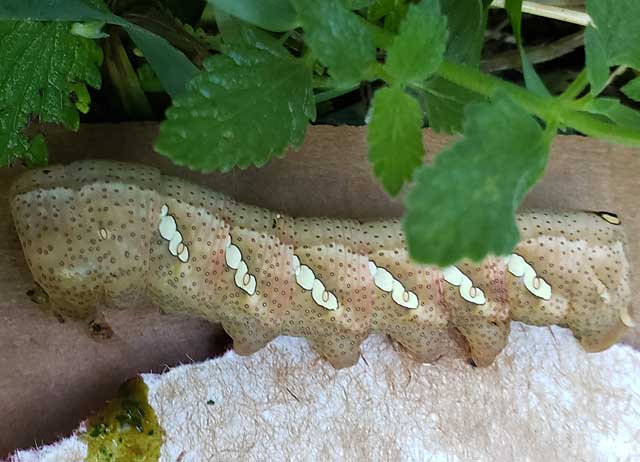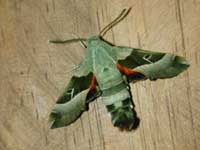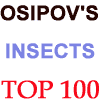|
|
Updated as per James P. Tuttle's The Hawk Moths of North America, August 3, 2019
Updated as per BAMONA; August 3, 2019
Inspired/dedicated as per personal comunication with Lynn Steinley (Eumorpha achemon, August 2, 2019); August 3, 2019
|
Pennington County, South Dakota, and Nearby Counties:
Bennett; Custer; Fall River; Haakon; Jackson; Shannon
Sphingidae

Eumorpha achemon final instar, Rapid City, Pennington County, South Dakota,
August 2, 2019, courtesy of Lynne Steinley.
This site has been created by Bill Oehlke.
Comments, suggestions and/or additional information/sightings are welcomed by Bill.
This page is inspired by and dedicated to Lynne Steinley who provides the Eumorpha achemon images on this page.
This page will also serve as a checklist for the following southwestern counties in South Dakota: Bennett; Custer; Fall River; Haakon; Jackson; Shannon.
Twenty-four Sphingidae species are listed for South Dakota on the BAMONA website as of August 3, 2019. Most of those species plus some
additions are anticipated in Pennington County (eleven are reported from Pennington County on BAMONA as of August 3, 2019). It is hoped that this checklist, with the
thumbnails and notes, will help you quickly identify the moth larvaee you are likely to encounter.
A "WO" after the species name indicates that I (William Oehlke) expect that this moth is present or might be present.
A "Pennington" indicates the moth is reported on BAMONA and/or in Lepidoptera of North America, #1. Distribution of
Sphingidae of Western North America, an excellent little booklet available through Paul Opler. This booklet shows none for your county, but it provides useful
data for interpolations.
Please help me develop this list with improved, documented accuracy by sending sightings (species, date, location), preferably with an
electronic image, via email to Bill Oehlke.
Please also send your sightings to BAMONA, an excellent resource, via link at top of page or to the left.
Pennington: Ceratomia undulosa; Manduca quinquemaculatus; Sphinx vashti; Pachysphinx occidentalis; Smerinthus cerisyi;
Hemaris diffinis; Eumorpha achemon; Amphion floridensis; Hyles gallii; Hyles lineata; Proserpinus juanita;
Bennett: Sphinx vashti; Smerinthus jamaicensis; Hyles lineata;
Custer: Ceratomia amyntor; Sphinx chersis; Sphinx vashti; Paonias myops; Smerinthus cerisyi; Hemaris diffinis; Hyles lineata;
Fall River: Hemaris diffinis; Eumorpha achemon; Hyles lineata;
Haakon: Ceratomia undulosa; Pachysphinx modesta; Paonias myops; Hemaris diffinis;
Jackson: Manduca quinquemaculatus; Paonias myops; Eumorpha achemon; Hyles euphorbiae;
Shannon: Sphinx vashti; Hemaris diffinis.
Visit Pennington County Sphingidae Larvae/caterpillars.
If you are travelling you can visit national checklists for all countries in North, Central and South America.
Visit South Dakota Catocala: Underwing Moths
Sphinginae subfamily
Sphingini tribe:
 |
Ceratomia amyntor
WO/Custer,
the Elm Sphinx or Four-horned Sphinx
The upperside of the forewing is brown with dark brown and white
markings including a white costal area near the wing base, dark
streaks along the veins, and a white spot in the cell.
Larvae feed on Elm (Ulmus), birch (Betula), basswood (Tilia), and
cherry (Prunus). |
 |
Ceratomia undulosa
WO/Pennington/Haakon, the Waved
Sphinx
The upperside of the forewing is pale brownish gray with wavy black
and white lines and a black-outlined white cell spot.
It is named for the wavy lines on the forewings. |
 |
Manduca quinquemaculatus
WO/Pennington/Jackson,
the Five-spotted Hawkmoth
The moth abdomen usually has five but sometimes six pairs of yellow
bands. The upperside of the forewing is blurry brown and gray.
I suspect if you grow tomatoes, you are likely to encounter it.
|
 |
Sphinx chersis
WO/Custer,
the Northern Ash Sphinx or Great Ash Sphinx
The upperside of the forewing is soft dark gray to blue-gray with a
series of black dashes, one of which reaches the wing tip.
|
 |
Forewings, long and slender, are held close to the body when the moth
is at rest.
|
 |
Sphinx luscitiosa
WO,
the Canadian Sphinx or
Clemen's Sphinx
The upperside of the forewing is yellowish gray in males and pale
gray with a faint yellow tint in females. In both sexes, the dark
border on the outer margin widens as it approaches the inner margin.
|
 |
Sphinx vashti
WO/Pennington/Bennett/Custer/Shannon, the Snowberry Sphinx
The upperside of the forewing has a narrow black subterminal line
bordered by a white inverted V-shaped line on the outside, and a
black line running inwards from the apex of the wing.
It is most often found in montane woodlands and along streamcourses.
|
 |
Amorpha juglandis
WO?? generally more eastery,
the Walnut Sphinx
The adults are also highly variable; sometimes wings of an individual
may be all one color or may have several colors, ranging from pale to
dark brown, and may have a white or pink tinge. Patterns range from
faint to pronounced.
See the file for the female; she is different.
|
 |
Pachysphinx modesta
WO/Haakon,
the Modest Sphinx or Poplar Sphinx
It is fond of poplars and
willows.
This moth has a large, heavy body, and females can be remarkably
plump. |
 |
This one is quite similar to Pachysphinx modesta, with modesta
being smaller and darker. There are two color forms: the upperside of the forewings is yellow brown in the pale form and dark gray in the dark form.
Lines and bands are well-defined.
|
 |
The outer margin of the forewing is quite wavy. There is a dark cell
spot and a dark oblique line mid wing from the costa almost to the
inner margin. Basic ground colour is pinkish brown.
|
 |
Paonias myops WO/Custer/Haakon/Jackson, the Small-eyed Sphinx.
Named for the small eye-spot in the hindwing, this moth has a wide
distribution. Both sexes rest with wings parallel to the resting
surface, with the upper lobes of the hindwings protruding above the
forewings.
|
 |
Smerinthus cerisyi
WO/Pennington/Custer, the Cerisyi's
Sphinx or One-eyed Sphinx:Larvae feed on poplars and willows.
Flight would be from late May-July as a single brood.
|
 |
Smerinthus jamaicensis closely resembles Smerinthus cerisyi, but jamaicensis is much smaller with larger blue patches on more
vibrant and deeper purple in the lower wings.
|
Macroglossinae subfamily
Dilophonotini tribe:
 |
Hemaris thysbe
WO, the Hummingbird Clearwing
It is not difficult to see why many gardeners would mistake an
Hemaris thysbe moth for a small hummingbird as it hovers,
sipping nectar from flowers through a long feeding tube.
|
 |
Hemaris diffinis
WO/Pennington/Fall River/Haakon/Shannon, the
Snowberry Clearwing or Bumblebee Moth
Adults mimic bumblebees and are quite variable, both geographically
and seasonally. The wings are basically clear, with dark brown to
brownish-orange veins, bases and edges. The thorax is golden-brown to
dark greenish-brown.
|
Philampelini tribe:
 |
Eumorpha achemon
LS/Pennington/Fall River/Jackson,
the Achemon Sphinx
Larvae feed upon Grape (Vitis), Virginia Creeper
(Parthenocissus quinquefolia) and other vines and ivies
(Ampelopsis).
Larvae occur in both a light (green) form and a darker (tan/brown) form.
|
Macroglossini tribe:
 |
Amphion floridensis, Pennington, Nessus Sphinix.
This day flier is widely distributed. If you have Virginia Creeper,
you probably have the Nessus Sphinx. Two bright, distinct, narrow
yellow bands are often visible on the abdomen.
|
 |
Darapsa myron
WO, the Virginia Creeper Sphinx or the Grapevine Sphinx
The forewing upperside is dark brown to pale yellowish gray, with an
olive tint.
On the costal margin there is a dark rectangular patch, although this
may be reduced or absent. The upperside of the hindwing is pale
orange.
|
 |
Hyles euphorbiae
WO/Jackson, the Spurge Hawk Moth
The body is light brown with various white and dark brown
markings, while the wings have a conspicuous tan, brown, and pink or
red color pattern.
|
 |
Hyles gallii WO/Pennington, the Bedstraw Hawk Moth or Gallium Sphinx
Larvae feed on Epilobium angustifolium and Galium. I
expect flight is late May-July with a possible fall flight as well.
|
 |
Hyles lineata
WO/Pennington/Bennett/Custer/Fall River, the White-lined Sphinx
The forewing upperside is dark olive brown with paler brown along the
costa and outer margin, a narrow tan band running from the wing tip
to the base, and white streaks along the veins.
|
 |
The upperside of the forewing is pale gray-green with a deep
green-brown median area and a white dash at the wing tip.
rare if present
|
 |
This moth is very much under reported across the United States. It
is a rapid day flier so is probably not in too many collections.
Grape and Virginia Creeper are popular larval hosts. generally more easterly
|
|
|
Enjoy some of nature's wonderments, giant silk moth cocoons.
These cocoons are for sale winter and fall. Beautiful Saturniidae moths will emerge the following spring and summer.
Read Actias luna rearing article. Additional online help available.
Use your browser "Back" button to return to the previous page.
This page is brought to you by Bill Oehlke and the
WLSS. Pages are on space rented from Bizland. If you would like to become a "Patron of the Sphingidae Site", contact Bill.
Please send sightings/images to Bill. I will do my best to respond to requests for identification help.
 | 
Show appreciation for this site by clicking on flashing butterfly to the left.
The link will take you to a page with links to many insect sites. |


























